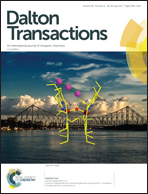Synthesis and characterisation of ruthenium–nitrosyl complexes in oxygen-rich ligand environments†
Abstract
A series of new {Ru–NO}6 complexes containing Kläui's tripodal oxygen ligand, [CpCo{P(O)(OMe)2}3]− (LOMe), and substituted catecholates have been prepared by chloride exchange with [Ru(LOMe)(NO)Cl2]. The [Ru(LOMe)(NO)(cat)] complexes (cat = dianion of catechol, 3,5-di-tert-butylcatechol, tetrabromocatechol, or 2,3-dihydroxynaphthalene) demonstrate spectroscopic features and redox properties consistent with the electronic character of the catecholate ligands. Several of the compounds display reversible oxidation events by cyclic voltammetry arising from the redox non-innocence of the catecholate ligands. Chemical oxidation of the di-tert-butylcatecholate complex, [Ru(LOMe)(NO)(tBu2cat)], with AgBF4 affords [Ru(LOMe)(NO)(tBu2semiquin)](BF4), a {Ru–NO}6 species that contains a semiquinone ligand. Photolysis of the semiquinone complex results in loss of NO and formation of the corresponding quinone complex, [Ru(LOMe)(CH3CN)(tBu2quin)](BF4). By contrast, photolysis of [Ru(LOMe)(NO)(Br4cat)], which contains the tetrabromocatecholate ligand, results in loss of NO and formation of the Ru(III) complex, [Ru(LOMe)(CH3CN)(Br4cat)]. Each of the new compounds represents a rare example of a Ru complex in an oxygen-rich ligand field, which may serve as a molecular model for heterogeneous catalysts comprising noble metal atoms dispersed on metal oxide supports.



 Please wait while we load your content...
Please wait while we load your content...